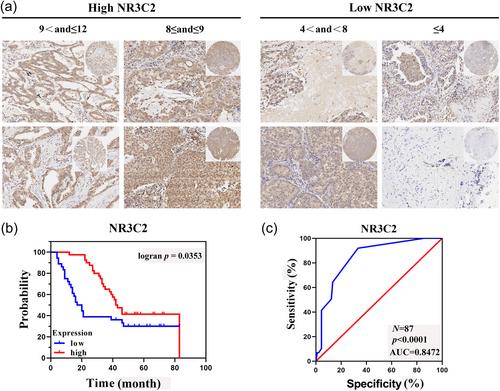Non-small cell lung cancer (NSCLC), including the lung squamous cell carcinoma (LUSC) and lung adenocarcinoma (LUAD) subtypes, is a malignant tumor type with a poor 5-year survival rate. The identification of new powerful diagnostic biomarkers, prognostic biomarkers, and potential therapeutic targets in NSCLC is urgently required.
The UCSC Xena, UALCAN, and GEO databases were used to screen and analyze differentially expressed genes, regulatory modes, and genetic/epigenetic alterations in NSCLC. The UCSC Xena database, GEO database, tissue microarray, and immunohistochemistry staining analyses were used to evaluate the diagnostic and prognostic values. Gain-of-function assays were performed to examine the roles. The ESTIMATE, TIMER, Linked Omics, STRING, and DAVID algorithms were used to analyze potential molecular mechanisms.
NR3C2 was identified as a potentially important molecule in NSCLC. NR3C2 is expressed at low levels in NSCLC, LUAD, and LUSC tissues, which is significantly related to the clinical indexes of these patients. Receiver operating characteristic curve analysis suggests that the altered NR3C2 expression patterns have diagnostic value in NSCLC, LUAD, and especially LUSC patients. Decreased NR3C2 expression levels can help predict poor prognosis in NSCLC and LUAD patients but not in LUSC patients. These results have been confirmed both with database analysis and real-world clinical samples on a tissue microarray. Copy number variation contributes to low NR3C2 expression levels in NSCLC and LUAD, while promoter DNA methylation is involved in its downregulation in LUSC. Two NR3C2 promoter methylation sites have high sensitivity and specificity for LUSC diagnosis with clinical application potential. NR3C2 may be a key participant in NSCLC development and progression and is closely associated with the tumor microenvironment and immune cell infiltration. NR3C2 co-expressed genes are involved in many cancer-related signaling pathways, further supporting a potentially significant role of NR3C2 in NSCLC.
NR3C2 is a novel potential diagnostic and prognostic biomarker and therapeutic target in NSCLC.


